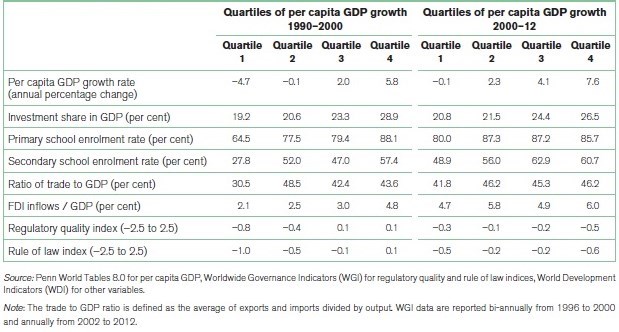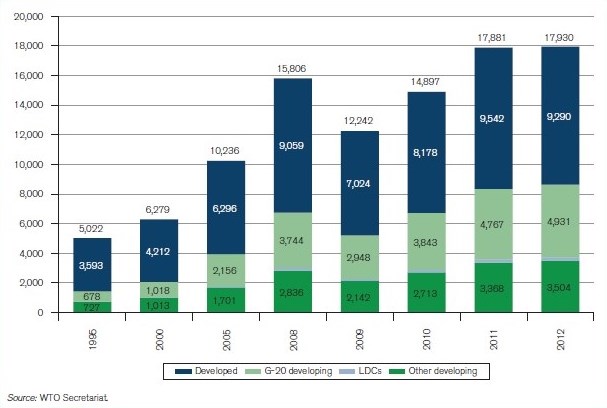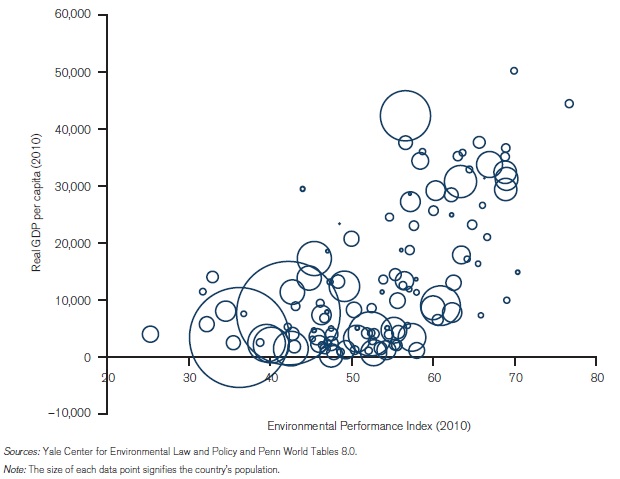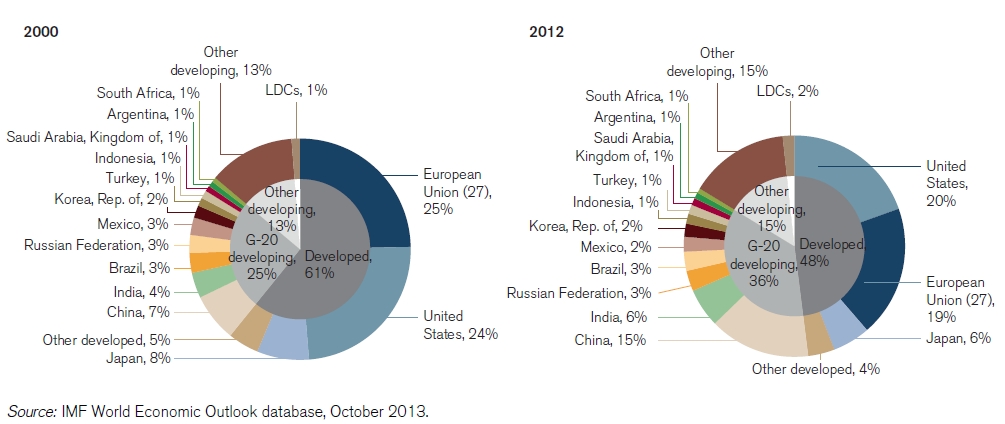Discussions
The rise of developing countries in the world economy and environmental considerations of development
Gavin van der Nest, tralac Researcher, comments on the findings of the WTO’s World Trade Report 2014 on Trade and Development
The recently released World Trade Report 2014 of the World Trade Organization has highlighted the increasingly important role that developing economies play in the global economy. The Report shows that developing countries have become increasingly integrated into the world economy through their growing shares in Gross Domestic Product (GDP) as well as trade. Additionally, the Report points out relationships between economic and social development and the environment. It also gives insight into how trade may contribute to environmental preservation.
The Report found that greater integration into the world economy as well as GDP growth moved together. World output share for developing countries has increased from 23% in 2000 to 40% in 2012 whilst their share in world trade has also risen to 48% in 2012 from 33% in 2000. This may be attributed to G-20 developing nations (which is distinct from the G-20 major economies); reducing their applied tariffs by over 5%, their commitment to bound rates for more than 80% of their tariff lines as well as a reduction in bound rates by approximately 10% over the last decade. This has clearly been conducive to trade which led to greater integration into the world trade economy and a larger share in trade.
Encouragingly, the Report has shown that low- and middle-income countries have been gaining on industrial economies in terms of per capita income and various other measures of quality of life. These rates of convergence may be attributed to both faster growth in the developing world as well as deceleration of growth in developed economies. These high growth rates have mostly been associated with exporters of natural resources, which have benefited through increases in commodity prices. It remains to be seen how long such prices will be sustained and whether the proceeds from primary exports are filtered through the economy to allow for industrial diversification and development.
However, the development story is not just about growth. GDP growth allows for the creation of economic resources to improve living conditions and there tends to be a positive link between human development indexes and GDP per capita. The link between development and growth is not absolute and governments need to respond with relevant policies that are able to address social and environmental concerns that may arise.
Table 1: Sources of economic growth in developing economies, 1990-2000 and 2000-12 (annual percentage change, per cent, and indices -2.5 to 2.5)

Source: World Trade Report 2014
Table 1 summarises prominent features of economic growth in developing countries over the periods 1990-2000 and 2000-12. Considering the quartiles of per capita GDP growth it is clear that all quartiles over 2000-12 showed accelerated growth compared to the 1990s.
Table 1 shows an increase in the ratio of trade to GDP for all quartiles excepting the second quartile in the 2000-12 period. This has shown that over the years trade has contributed towards a larger share in GDP.
Trade openness has a positive effect on GDP growth. Trade liberalisation leads to improvements in resource allocation and specialisation according to comparative advantage as well as the exploitation of economies of scale that raises GDP. Open economies also tend to exhibit accelerated growth as trade encourages investment and innovation, provides the catalyst of international technological spill-overs and may possibly even lead to institutional reforms.
The Report has highlighted both a rising share of world trade in GDP as well as a rise in GDP per capita across the world since 1980. However, it is difficult to establish the direction of causality for this phenomenon. What is apparent is that there is a long-run relationship between trade and GDP.
The fastest growth was exhibited by oil-exporting least developed countries (LDCs) in the post-2000 period, which was driven by rising prices of primary commodities. In particular, LDC exporters of agricultural products displayed income growth of an impressive 3.9% per year since 2000 after dismal performances during the 1990s. G-20 developing economies in general exhibited similarly impressive growth.
Figure 1: Shares of selected economies in world GDP at purchasing power parity (percentage)
Source: World Trade Report 2014
Figure 1 shows that there has been an improvement in living standards over time in developing countries. South Africa has remained relatively flat over this period. There has been a noticeable increase in the share of developing countries in world GDP at purchasing power parity. Their collective share has increased from 39% of global output in 2000 to 52% in 2012. Most of this increase may be attributed to G-20 developing economies where their share in exports increased from 25% to 36%with other developing countries also showing modest improvements from 13% to 15% over the same period.
Figure 2: Evolution of world merchandise exports by level of development, 1995 -2012 (US$ billion)

Source: World Trade Report 2014
Figure 2 highlights the increasing share of world exports from developing countries. Between 1995 and 2000, the share of G-20 developing countries increased from 13.5% to 16.2%. This share increased to 27.5% in 2012 in spite of the global financial crisis of 2009. Over the 1995 to 2012 period, the share of developing economies in world GDP at PPP increased significantly from 28.4% in 1995 to 48.1% in 2012. There has been a pronounced shift towards exports from the developing world over this period.
However, economic growth in itself is not a panacea for all and environmental quality is a key consideration beyond income growth. The Report has made use of an index, the Environmental Performance Index (EPI), to measure the strength of the relationship between income and environmental performance.
Environmental health and eco-system viability indicators include pollution, access to clean drinking water, various emissions of pollutants and critical habitat protection. Higher values on the index represent better environmental quality. Amongst the fast-growing developing economies, it was found that some had improved their environmental performance whilst others had shown deterioration. The improvements may be attributed to focused policies on emissions reductions and greater environmental awareness whilst at the other extreme deteriorations have been driven by coal-intensive industrial development at the expense of the environment.
Figure 3: Real per capita GDP and environmental performance (2005 PPP$, weighted by population in 2010)

Source: World Trade Report 2014
Figure 3 shows an almost linear and positive relationship between Real GDP per capita and the EPI. This shows that countries with higher incomes are more able to pay for environmental preservation. There is an opportunity for trade to have a significant impact on environmental preservation through indirect ways. This may be especially through the promotion of trade and trade policies that promote sustainable economic growth and therefore contribute indirectly to environmental clean-up.
The “Environmental Kuznets Curve” provides a hypothesis for the correlation between per capita income and environmental deterioration. At the onset of development, environmental quality is hypothesised to degrade as the country moves away from agriculture to pollution intensive manufacturing. This is particularly pertinent for Africa as its industrial base grows. As a country moves beyond a certain level of income, the quality of the environment should improve. This is as a natural result of; the composition of production changing from natural resource-intensive goods to services, changes in consumption preferences for environmentally friendly goods at higher income levels as well as an improvement in the quality of institutions which are better able to enforce regulatory measures in addressing environmental concerns.
Trade in particular is an important factor in affecting the relationship between growth and the environment. Opening up to trade increases the availability and lowers the costs of environmentally friendly technologies. Greater demand for a cleaner environment in more advanced economies may create an incentive to adopt cleaner technologies in less advanced economies. This could be argued for multinational companies, which due to concerns on reputation and economies of scale would require far more stringent environmental measures for their satellite locations than required by their host country.
Trade continues to play an important role in the development of the world economy and the narrowing of income gaps between developed and developing nations. Developing countries have increased their share in world GDP and exports. As countries continue to develop and their GDP increases, their environmental performance should also increase. It is hoped that not only will the environment be preserved through the promotion of trade and trade policies that encourage sustainable growth but such actions may lead to a new growth path of green economic development.


